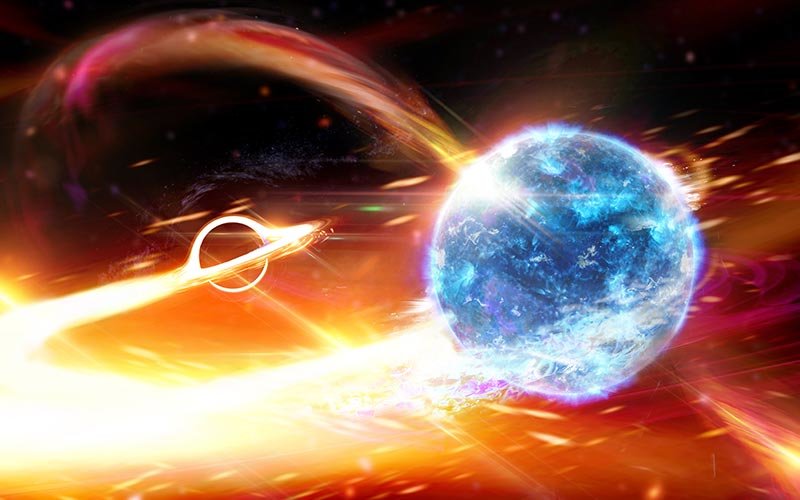
Gravitational wave detectors in the U.S. and in Italy received an unusual, loud signal on Aug. 14, 2019, from the merger of two compact objects in the universe that produced gravitational waves — ripples in the fabric of space-time. This signal came to Earth from a kind of cosmic system that has never been observed by scientists.
Unlike previous observations of gravitational waves, this was a unique mashup of a black hole 23 times the mass of the sun — and about 800 million light-years away from Earth — with an unknown, lighter object.
Before the two objects of unequal mass merged, the black hole was about nine times more massive than its lighter companion, making this the most extreme mass ratio known for a gravitational-wave event.
“We can’t tell exactly what the lighter compact object is — whether it is a black hole or a neutron star,” said Philippe Landry, Cal State Fullerton postdoctoral research associate. “It’s a little heavier than we thought possible for a neutron star and quite a bit lighter than known black holes. It may well be the lightest black hole ever discovered. The most exciting thing is the mystery surrounding the lighter compact object’s identity.”
This new discovery, announced today (June 23) by the LIGO Scientific Collaboration and the European Virgo Collaboration, was published in The Astrophysical Journal Letters. The journal paper describes the cosmic merger and burst of gravitational waves, caused by the collision of massive objects.
The LIGO Scientific Collaboration, which includes faculty researchers from Cal State Fullerton’s Nicholas and Lee Begovich Center for Gravitational-Wave Physics and Astronomy (GWPAC), carries out the research of the National Science Foundation-funded Laser Interferometer Gravitational-Wave Observatory, known as LIGO.
“This discovery is important because it tells us something we didn’t know about the population of compact objects in the universe,” Landry explained. “It’s an opportunity to refine the scientific models that describe the death of massive stars and their afterlife as black holes or neutron stars. Those models feed into the stellar and galactic evolution that explains how our solar system formed, how all the chemical elements made it to Earth, and ultimately, where we fit into the history of the universe.”
Is the Lighter Object a Neutron Star or a Black Hole?
In addition to Landry, GWPAC’s Joshua Smith, professor of physics and Dan Black Director of Gravitational Wave Physics and Astronomy; Jocelyn Read and Geoffrey Lovelace, both associate professors of physics; and their former research students, are all co-authors of the new peer-reviewed journal paper.
“This first-of-its-kind detection challenges scientists’ understanding of the masses that compact objects have in merging systems,” Smith said. “It’s a truly remarkable event whether it be the lightest black hole or heaviest neutron star ever seen in a binary system.”
While the lighter object’s mass is an unexpected find with gravitational waves, it suggests that there is a population of super-heavy neutron stars or underweight black holes out in the universe that scientists didn’t know existed.
“That, in turn, dramatically changes our understanding of how black holes and neutron stars form and pair up,” Landry said.
Landry, who earned a doctorate in physics from the University of Guelph in Canada, played a major role by helping to lead an analysis that sought to determine the identity of the lighter object and writing significant portions of the journal paper.
“We are especially proud of the contributions Dr. Landry made in the interpretation and description of this gravitational-wave signal,” Smith said.
CSUF Faculty-Student Researchers Contribute to Cosmic Event
The team of faculty and student researchers in GWPAC has been on the forefront of gravitational wave discoveries since the first-ever observation in 2015. The LIGO and the European Virgo detectors have since observed 11 mergers of black holes and two mergers of neutron stars, the first in 2017 and again in 2019. The LIGO Scientific Collaboration also is actively studying other potential candidates.
Landry is GWPAC’s second postdoctoral research associate and began working with physics faculty and students in 2019. Marissa Walker was CSUF’s first gravitational-wave postdoctoral research associate from 2017-19. Walker, now an assistant professor at Christopher Newport University in Virginia, and CSUF physics alumni Jeffrey Bidler, Eric Flynn (a doctoral student at Michigan State University), Sarah Hoback, Dakota Rose and Amauri Tapia also are co-authors of the journal paper.
Immediately following this new event last August, dubbed GW190814 for the date it was detected, scientists speculated that it might be the first-ever neutron star-black hole merger. But after months of analysis of the data by CSUF and other LIGO scientists, the researchers could not be certain that it was a cosmic collision of a neutron star and black hole.
As part of Landry’s analysis to determine whether the lighter object was a neutron star or a black hole, he compared the lighter object’s mass to an estimate of the maximum mass a neutron star can reach.
“A neutron star can only get so heavy without collapsing into a black hole under its own weight. Because the matter inside a neutron star is so extreme, we don’t understand its properties very well, and as a consequence, we don’t exactly know the maximum mass,” he said.
“Learning about the maximum neutron star mass — and the properties of neutron star matter more generally with gravitational waves — is one of the main goals of my research. It’s very gratifying to have been part of a discovery that could reshape our understanding so drastically.”
Contact: Debra Cano Ramos, dcanoramos@fullerton.edu